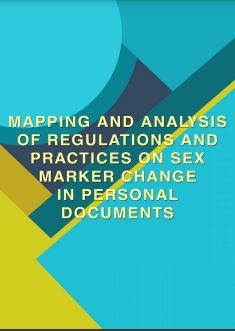Mapping and Analysis of Regulations and Practices on Sex Marker Change in Personal Documents
Mapping and Analysis of Regulations and Practices on Sex Marker Change in Personal Documents
Author(s): Nedim Seferović
Contributor(s): Amil Brković (Editor), Emina Bošnjak (Editor)
Subject(s): Gender Studies, Public Administration, Public Law
Published by: Sarajevo Open Centre
Keywords: sex marker change; personal documents; regulations; practices; public administration;
Summary/Abstract: When we think about a certain phenomenon and attempt to value ourselves in relation to it, we often fall into the trap of self-evidence. Certain terms and phenomena appear self-evident to us, to the point where we accept them without question. This trap of self-evidence is especially pronounced when it comes to gender and sex. The awareness of these issues is reflected in the fact that socially, historically and culturally conditioned stratification of the individuals’ gender roles equates them with their sex. By knowing the sex determination of an individual we meet, come across or see, observed on a binary scale where there are only two (anti)podes - male or female, we believe that we know the gender, and thus the socially imposed gender role. As a collective, we define how a man, a woman, a boy, or a girl should behave based on these gender roles. We define their emotional characteristics, men’s and women’s appearance, manners and behaviour on various occasions based on these roles, often noticing only comparative differences between them. The deep-rooted recognition of these differences in the male-female dichotomy is frequently an impediment to accepting the possibility that these differences are sometimes interconnected, varied, and subject to change beyond sex conditioning. Overstepping these roles is perceived as excess, as a foreign, unknown, and thus unacceptable phenomenon. The reality, however, tells us otherwise. Observing gender and gender roles in such a simplified manner is unfounded and does not relate to the fact on which reality is constructed. In reality, gender roles are subject to change, interpretation, and different understandings rather than being immutable and assigned by external sources. There is a wide spectrum of gender identities between “man” and “woman”, all of which are as real and essential as they are, and which are a trait of a specific individual that deserves nothing less than acceptance and respect. Transgender persons express and experience their gender identity in a way that differs from traditionally conditioned ways. These individuals (self) identify as men, women, neither, both, or otherwise, and this identification is not based on their biologically assigned sex. Because of the disparity between biological sexual characteristics and their own gender perception, they feel the need to define their identity outside of the ascribed characteristics that gender brings. In some cases, such a definition of one’s own identity implies certain adjustments in terms of personal data. To define their identity in accordance with their feelings, a transgender person may be forced (or may desire) to alter (or change) their sex or name data through administrative procedures. Transgender persons in this segment, as in many others, often face prejudice, discrimination and non-acceptance. This negative attitude against transgender persons and their efforts to express their own gender and sex outside of conventionally and socially accepted patterns results in the denial of the possibility of their own conception of private and personal personality elements. It is, therefore, necessary to keep in mind that the question of gender and sex is ultimately a question of personality and, as such, is exclusively personal. When it comes to characteristics that are truly one’s own and not social, and to which these persons as individuals have a full right, which cannot be limited or denied by any arbitrariness that would stem from a sphere of fear of the unconventional, social constructs should not take precedence over any person’s right to self-determination. On the other hand, society has a positive commitment to transgender persons and any other person, to enable them (whether transgender or not) to enjoy the full spectrum of rights guaranteed by positive regulations and basic norms of civilization. This publication was prepared with the primary objective of providing basic information to public administration officers regarding the implementation of currently valid laws and bylaws in support of transgender persons’ rights and equality. Its goal is to serve as a resource for public administration officers to get more familiar with relevant legal solutions and best practices, which will be used in their work in cases of sex marker change in personal documents. Furthermore, the Handbook aims to improve the knowledge and capacity of BiH public administration representatives by providing clear guidelines and an effective model of legal recognition of gender identity, allowing them to perform best practices in terms of respecting the rights of transgender persons in sex reassignment procedures, with reference to good practices from the region and Europe.
Series: SOC — Ljudska prava
- Page Count: 55
- Publication Year: 2022
- Language: English
- Introduction
- Content File-PDF

